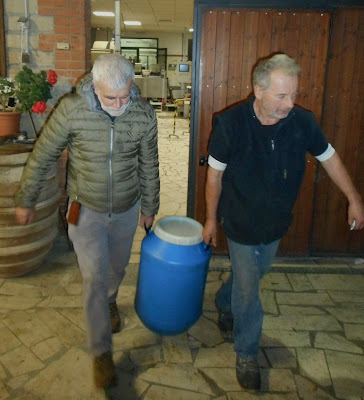Thursday, November 10, 2016
After The Pestilence
Across the olive-lined hillside from the picturesque village of Castelmuzio lies our friend Valerio Truffelli's olive orchard.
In November of 2013, Roger helped Valerio with his olive harvest and posted a long story on this blog about the harvest and how olives are turned into oil.
When we returned a year later, Roger asked if he could help again, but Valerio said there would be no harvest that year.
This gal was the culprit...the olive fruit fly. Previously unknown north of Rome, this fly swept into Toscana two years ago and decimated the olive crop.
Last year, the crop rebounded a bit but was still much smaller than normal.
Olives trees are like grape vines.
The same grapes grown on two different hills...or even the bottom or top of the same hill....produce wines with very different tastes, year in and year out.
Each individual grove of Tuscan olives produces oil with a distinct taste, because of differences in soil, drainage, and sunlight.
So it was with a great deal of curiosity that Roger returned to Valerio's trees to see what the olives looked like.
This year, much had changed.
Valerio is very old school. He had always eschewed modern harvesting techniques in favor of picking olives by hand...the old fashioned way.
But last year one of his friends who was helping with the harvest fell out of a tree and broke his leg.
...so this year, his wife Tina used a mechanical vibrating pitchfork to shake the olives out of the trees.
When we finished the first tree, things looked a bit sparse.
Three years ago, this net would have been covered with a plush carpet of olives.
Three years ago, the harvest from one mature tree would have filled this tub.
This year...take a look for yourself.
Seventy-five kilometers north of us, near Florence, our friends Brett and Piero got no oil at all from their trees.
Harvesting olives is not rocket science...which is why Valerio allows Roger to help.
Much more tricky is laying the nets out on the steep hillsides in a way that keeps the olives from rolling off.
Black olives, the mature ones, produce the most oil. But the green ones give the fresh oil a sharp peppery taste unlike anything you can find in the best gourmet food shop.
In three days of work, we harvested 440 lbs of olives.
They went to the press in nearby Castelmuzio...
...and the next day emerged as 35 liters of fresh oil.
A harvest much smaller than hoped for.
Enough to keep Valerio's family in oil for the year, but none of the normal surplus to trade for wine or meat.
And Carol can attest, there's nothing like the taste of fresh-pressed Tuscan olive oil.
The Tuscan model for making olive oil would never work in the United States. In the states, some big firm would buy the entire olive harvest from all the small farmers in the area, mix all the olives together to produce an oil with consistent flavor, then market it under its own brand.
Even for Valerio, producing his own olive oil makes no economic sense.
He could buy 35 liters of cold-pressed, extra virgin, premium olive oil for far less money than three days of lost business in his leather shop, plus tool rental and processing costs.
So Roger asked him why he did it.
He said, "Wealth is not the amount of money you have in the bank but the richness of your life."
Subscribe to:
Post Comments (Atom)













Reminds me of when Dan and I travelled around Spain in a rented car and stopped to watch and photograph olives being harvested. We stopped to visit the family and they gave us a few jars. Sis
ReplyDeleteSweet!
ReplyDeleteRF